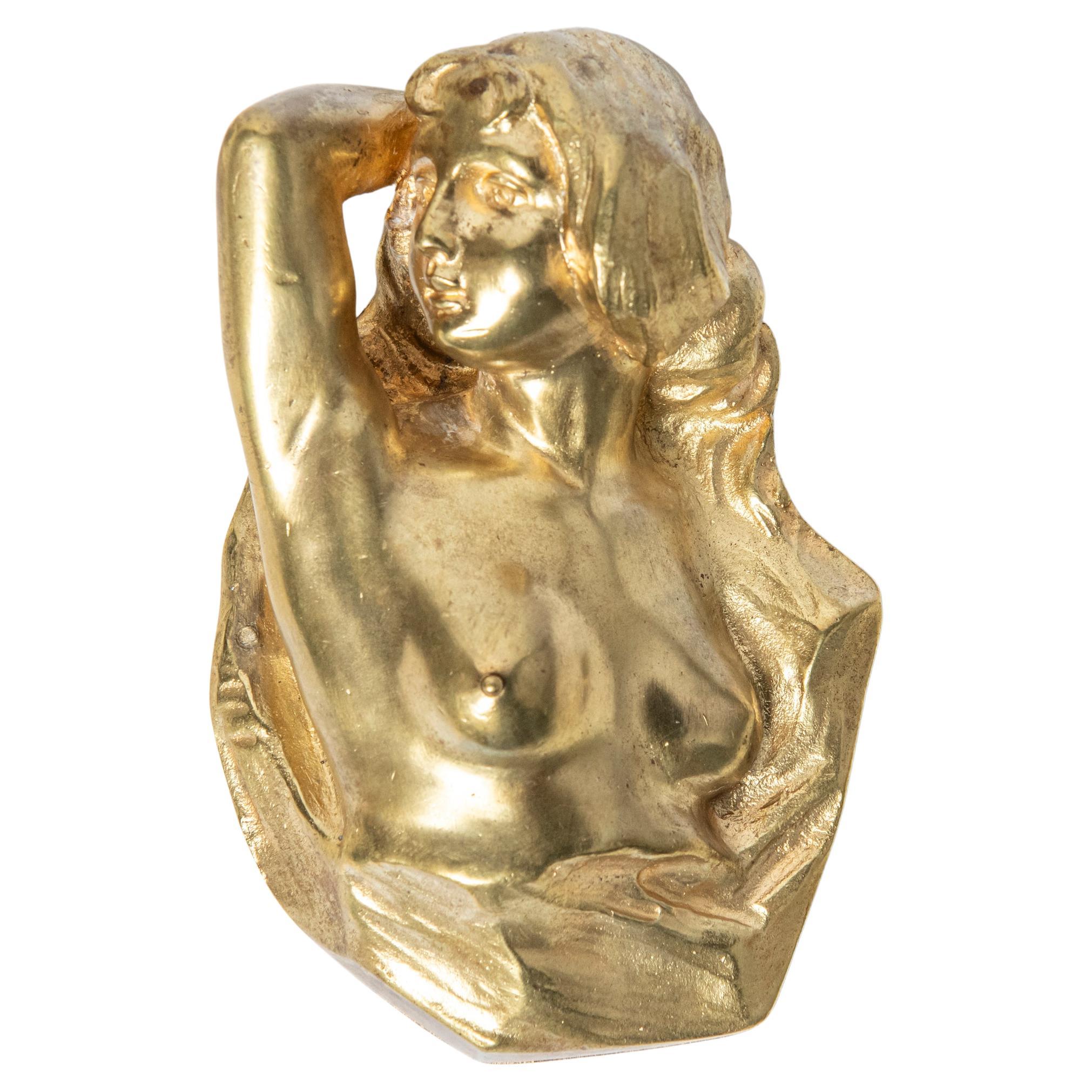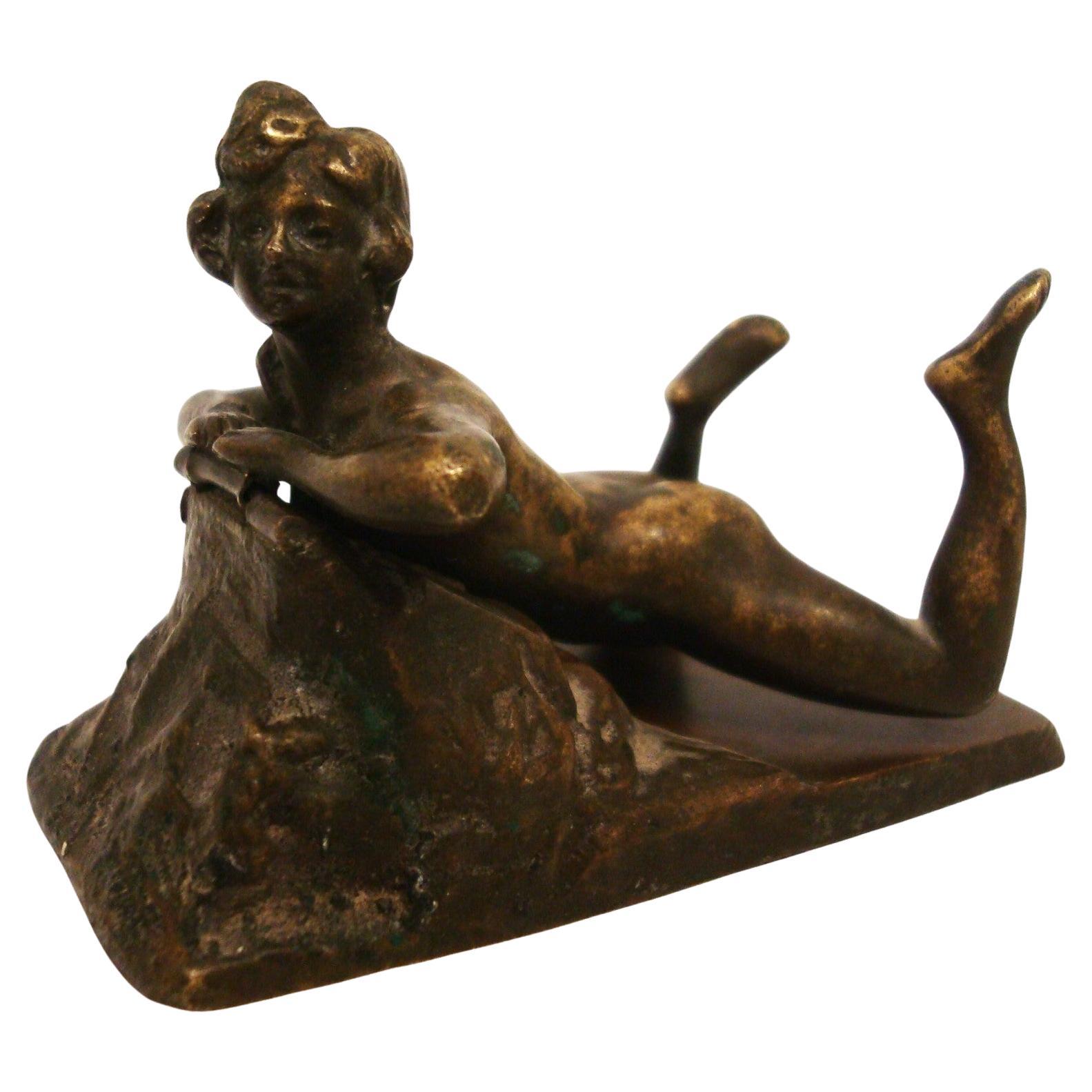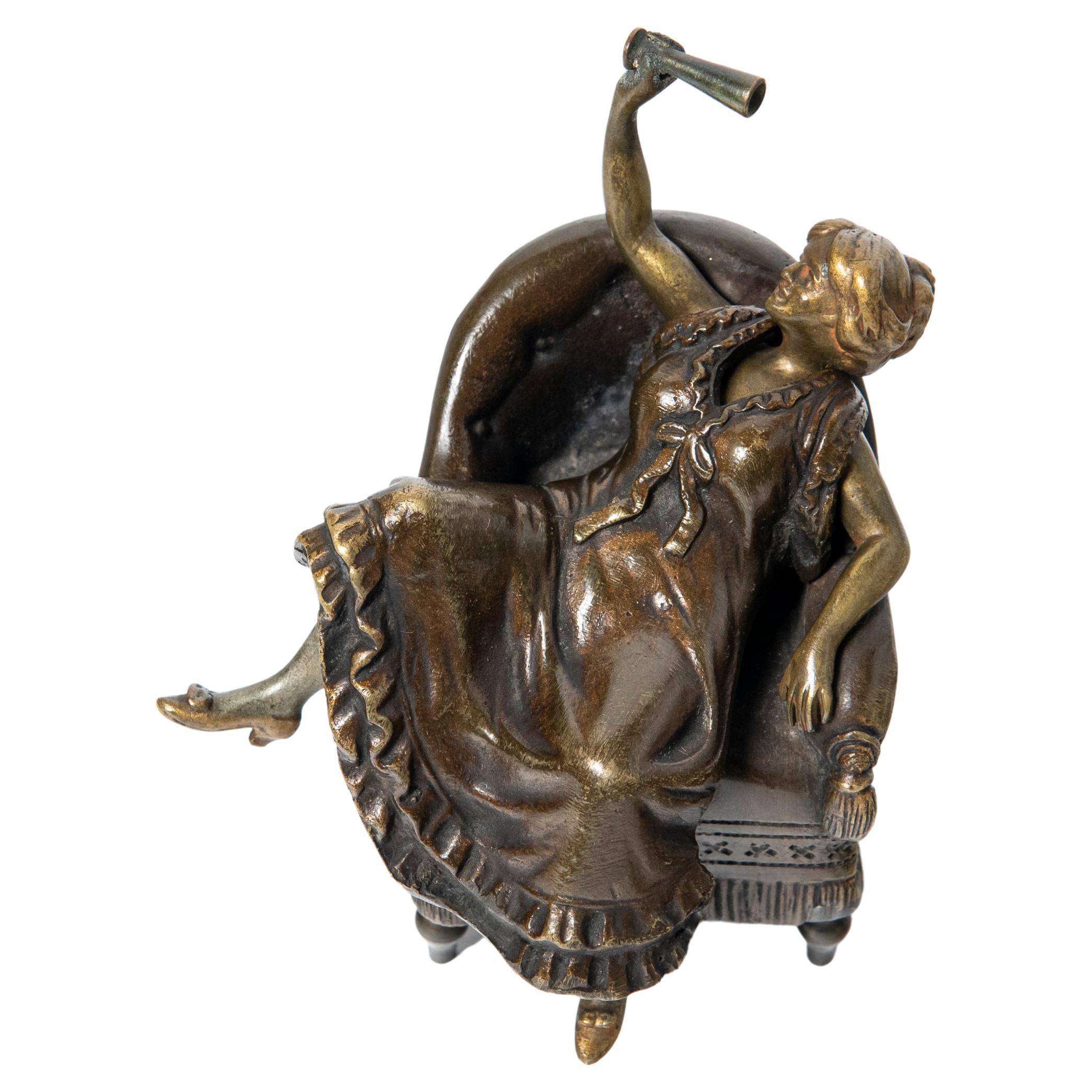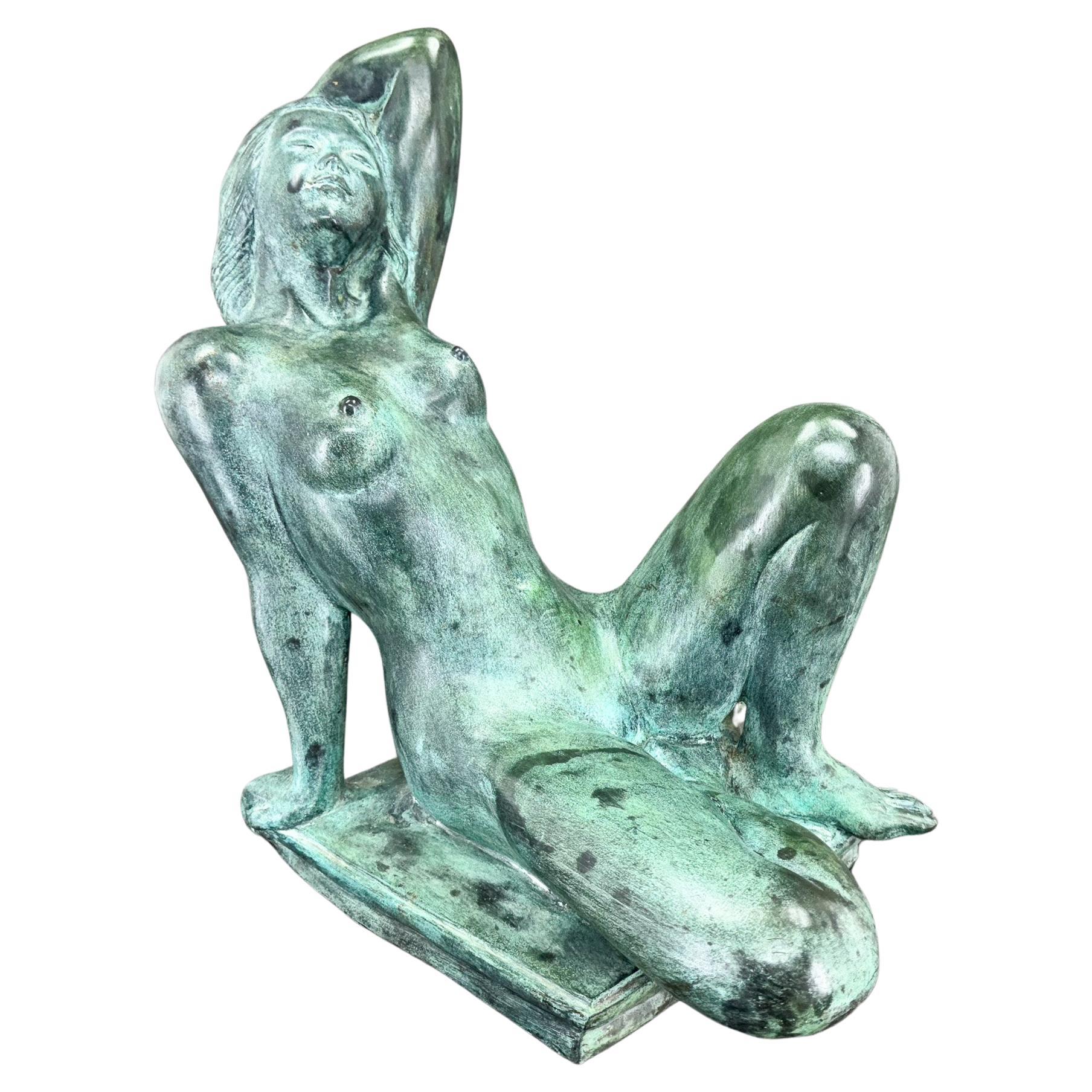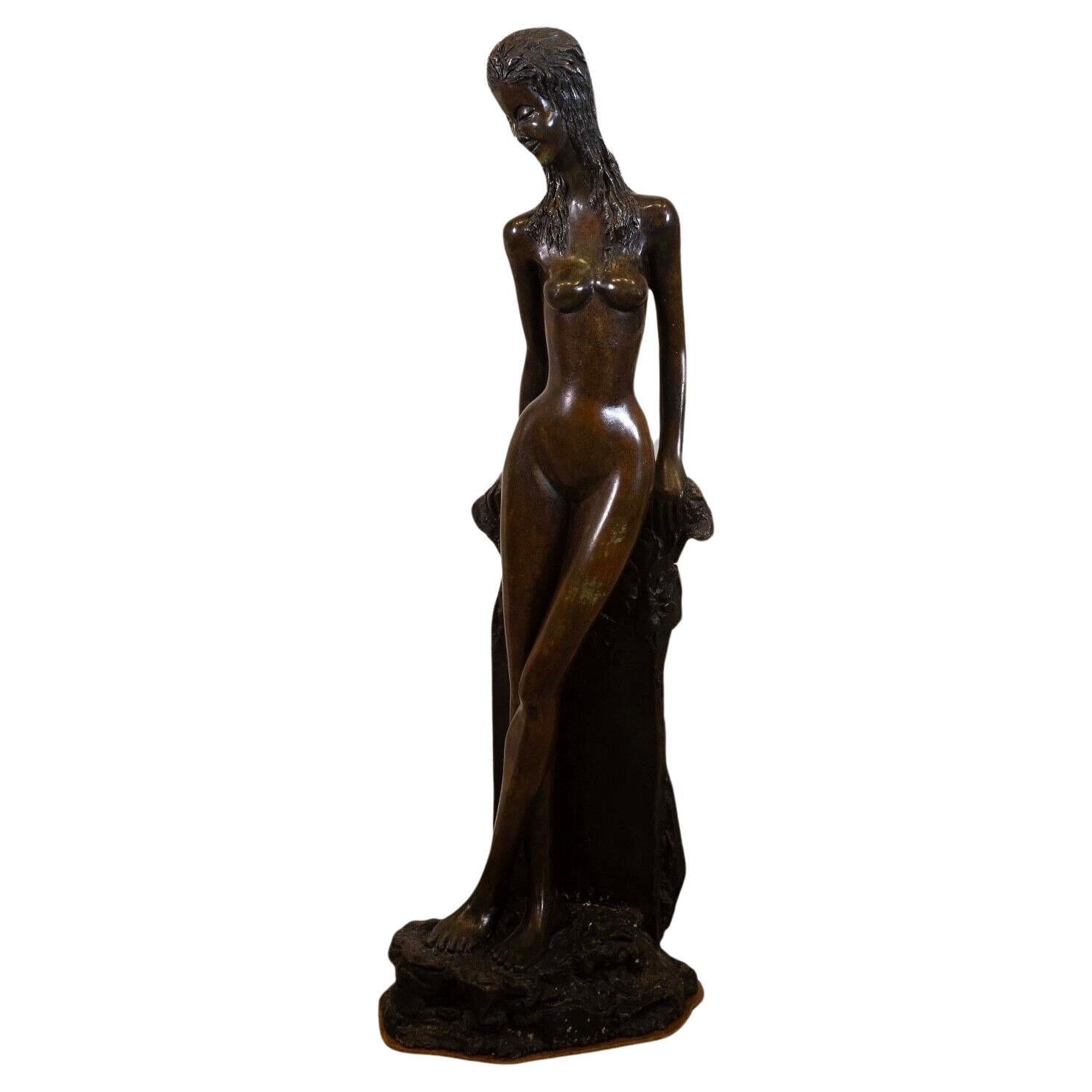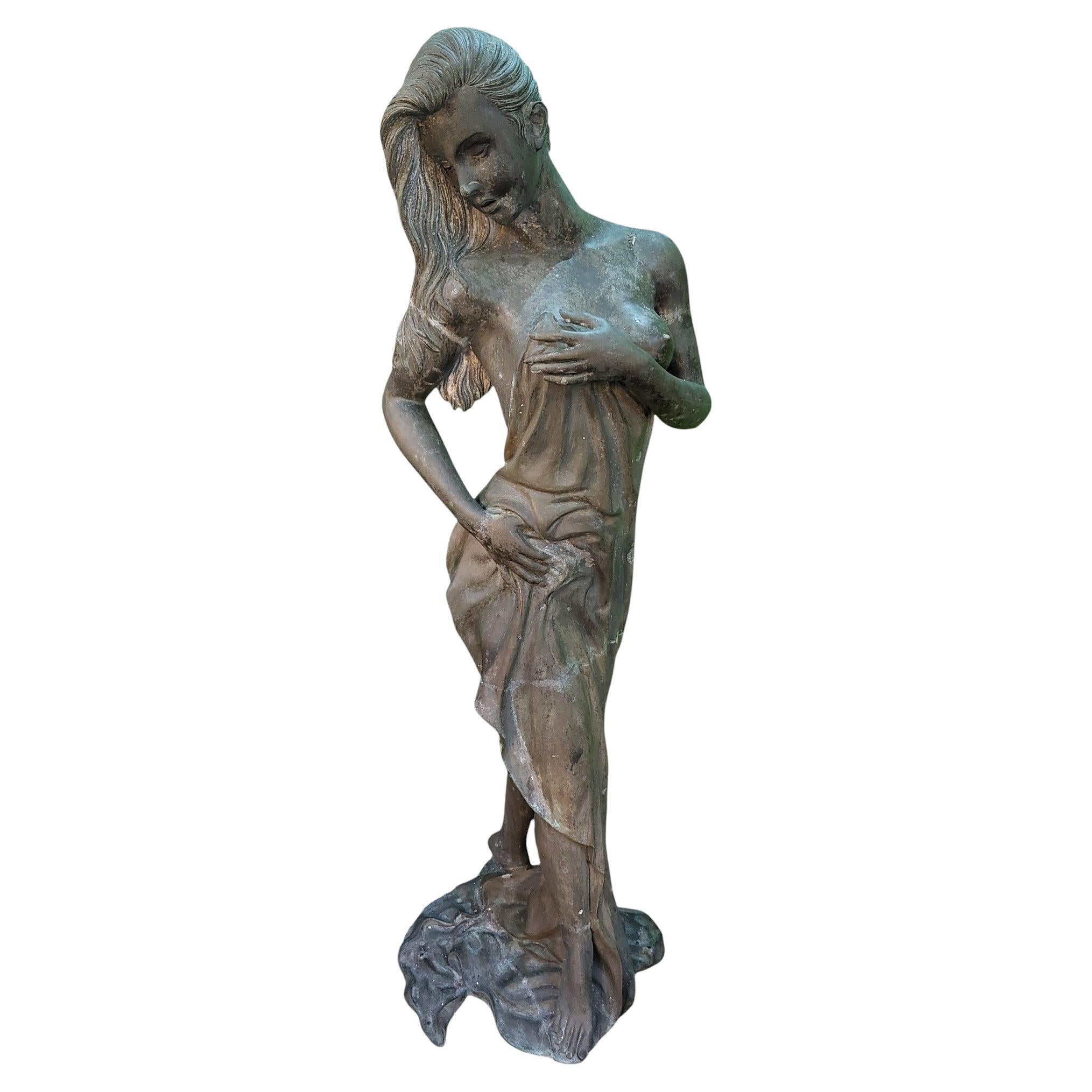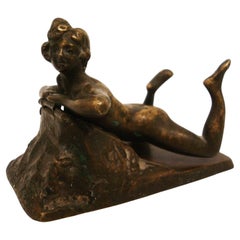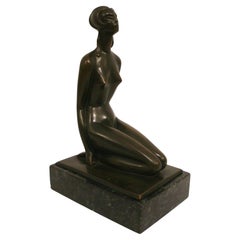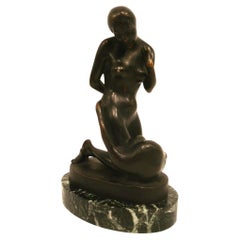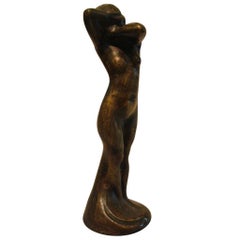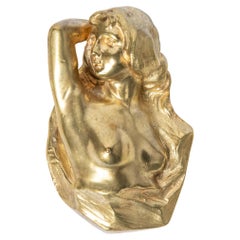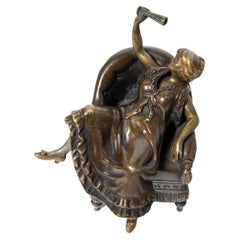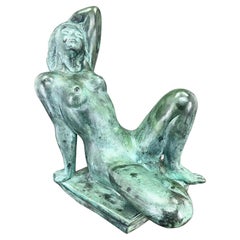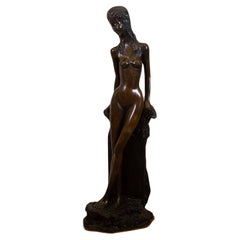Items Similar to Erotic / Nude Women Bronze Sculpture Table Bell Push, Austria, 1900´s
Want more images or videos?
Request additional images or videos from the seller
1 of 8
Erotic / Nude Women Bronze Sculpture Table Bell Push, Austria, 1900´s
$1,800
£1,366.78
€1,563.02
CA$2,514.86
A$2,797.07
CHF 1,460.55
MX$34,037.42
NOK 18,653.39
SEK 17,493.59
DKK 11,665.40
Shipping
Retrieving quote...The 1stDibs Promise:
Authenticity Guarantee,
Money-Back Guarantee,
24-Hour Cancellation
About the Item
Erotic / nude women bronze sculpture table bell push - Austria 1900´s
Talk about hard to find items! This impossible to believe bell push is the only erotic bell push we have ever seen. Normally you get a little boy, or an animal, but not here. You actually push the woman's nipple and that would alert your butler or servant to come to your quarters. If this doesn't put a smile on your face, nothing will. This is a great example of an erotic Vienna bronze.
We have specialized in the sale of Art Deco and Art Nouveau and Vintage styles since 1995. If you have any questions we are at your disposal. Pushing the button that reads 'View All From Seller'. And you can see more objects to the style for sale. Why are there so many antiques in Argentina?
In the 1880 – 1940 there was a grate wave of immigration encouraged by the periods of war that were taking place. 1st World War took place between 1914 and 1918 2nd World War took place between 1939 and 1945 The immigrants options were New York or Buenos Aires. Tickets were cheap and in Buenos Aires they were welcomed with open arms, as it was a country where everything was still to be done. Argentina was the country of new opportunities, labour was needed and religious freedom was assured, in many cases the of the family travel first until they were settled and then the rest of the family members join them. In the immigrant museum “Ellis Island Immigrant Building” in New York you can se the promotional posters of the boats that would take them to a new life. Between the years 1895 and 1896, Argentina had the highest DGP (gross domestic product) per capita in the world according to the Maddison Historical Statistics index, this situation arose due to the large amount of food being exported to European countries, which were at war. The Argentinean ships left the port of Buenos Aires with food, but they returned with furniture, clothes and construction elements, (it´s common to see this the old buildings of the historic neighbourhood of San Telmo, the beams with the inscription “Made in England)”, as well as many markets that were built in Buenos Aires, such us the San Telmo Market, whose structure was brought by ship and afterwards assembled in 900 Defensa Street. With the great influence of European immigrants living in the country, the children of the upper classes travelled to study in France, resulting in the inauguration of “La Maison Argentinienne”, on 27th of June 1928, in the international city of Paris, which hosted many Argentinians that were studying in Frace. It´s the fourth house to be built after France, Canada and Belgium, being the first Spanish-speaking one. Still in place today (17 Bd Jourdan, 75014, Paris, France). Many of the children of these wealthy families who attended international art exhibitions, museums and art courses abroad, took a keen interest in the European style. This is why Buenos Aires was at the time referred as “The Paris of South America”. Between the years 1890 and 1920 more than a hundred Palaces were built on Alvear Avenue the most exclusive avenue in Buenos Aires. Today some of these palaces have been transformed into museums, hotels and embassies. In the year 1936, the Kavanagh building was inaugurated, it was the tallest reinforced concrete building in South America. During 1994 the American Society of Civil Engineers distinguished it as an “international engineering milestone”, and it´s now considered a World Heritage of Modern Architecture. At the time was common to hire foreign architects such as Le Corbusier, who visited Buenos Aires/Argentina in 1929 and in 1948 he drew up the blueprints for a house built in La Plata City (which was declared a World Heritage Site). In 1947, the Hungarian architect Marcelo Breuer designed “Parador Ariston” in the seaside city of Mar del Plata. After an Argentinean student at Harvard University convinced him to come to Argentina. He worked on an urban development project in the Casa Amarilla, area of La Boca. The Ukrainian architect, Vladimiro Acosta, arrives in Argentina in 1928 and worked as an architect until que moved to Brazil. Antonio Bonet, a Spanish architect who worked with Le Corbusier in Paris, arrives in Argentina in 1937, where he carried out several architectural works and in 1938 designs the well-known BFK chair. Andres Kálnay, of Hungarian origin, made around 120 architectural masterpieces, among which the former Munich brewery stands out, he even made the furniture’s design. The German architect, Walter Gropius, director of the Bauhaus, lived in Argentina, where he wrote articles for “Sur” magazine and founded in Buenos Aires, an architectural firm with Franz Möller, who was also an architect, where he built two houses. At the same time several famous designers decided to immigrate to Argentina, among them we can find the well-known French designer, Jean-Michel Frank, who arrived in the country in 1940 and also worked for the Rockefeller family. Special pieces were made, which were sold exclusively in the country, such as the well-known German company “WMF”, who sold their products by catalogue, which were chosen by the ladies of high society in the list of wedding gifts, as well as the pieces designed by Christofle. The Swiss sculptor Alberto Giacometti, made special pieces for Argentinean mansions. In 1904 the first Jansen branch outside Paris was established in Buenos Aires, as the Argentinean clientele demanded a large amount of furniture, from the end of the 19th century to the mid-20th century. In 1970, the brand Rigolleau Argentina made pieces authorised by Lalique. The brands Maple and Thompson also set up shop in the country. The French plastic artist, Marcel Duchamp moved to Argentina in 1918-1919. Glass signed Gallé, Charder, Leverre, Schneider, Muller and other French firms. They were bought in flower shops and were given to ladies with beautiful floral arrangements. Some furniture manufacturers travelled to international fairs and bough the patterns to produce the furniture in Argentina, such as the furniture firm Englander and Bonta, who bought the patterns in Italy. It is worth mentioning that in Argentina we have the largest community of Italians outside of Italy, as it is estimated that 70 percent of the inhabitants have at least one Italian descendant, followed by Spanish immigrants. The most Important furniture stores in Argentina: Comte is founded in 1934 (under the direct management of Jean Michel Frank in 1940). Nordiska (Swedish company established in 1934). Churba in 1960, a company that brought foreign designers to present their furniture in the country: Denmark: (Arne Jacobsen, Finn Juhl, Bender Madsen, Ejner Larsen, Poul Kjaerholm, Hans Wegner) Sweden: (Hans Agne Jakobsson, Gustavsberg) United States: (Herman Miller) Finland: (Lisa Johansson, Folke Arstrom, Tapio Wirkkala, Alvar Aalto, Timo Sarpaneva) Swedish Factory: (Orrefors) Italy: (Littala, Vico Magistretti, Emma Gismondi, Gae Aulenti, Angelo Mangiarotti, Elio Martinelli, Gianna Celada, Angelo Mangiarotti, Mario Bellini, Carlo Scarpa) Finland: (Olivia Toikka) Plata Lappas (Lappas Silver): a goldsmith shop founded in 1887 in Argentina by Alcibiades Lappas of Greek origin. In 2019, in Argentina took place “the Art Deco world congress” . Argentina currently has more than 100 Art Deco buildings and another 90 Art Nouveau buildings throughout the city of Buenos Aires. Argentina is a country that has not been involved in many wars, which is why it has been a refuge for works of art and antiques from different periods of time, unlike European countries. That is way many collectors, museums and antique dealers from all over the world visit it, you should not miss the opportunity to visit this great country.
- Similar to:Franz Bergmann (Artist)
- Dimensions:Height: 1.58 in (4 cm)Width: 3.94 in (10 cm)Depth: 2.76 in (7 cm)
- Style:Art Nouveau (Of the Period)
- Materials and Techniques:
- Place of Origin:
- Period:
- Date of Manufacture:1900s
- Condition:Rewired. Wear consistent with age and use.
- Seller Location:Buenos Aires, AR
- Reference Number:1stDibs: LU2027331461542
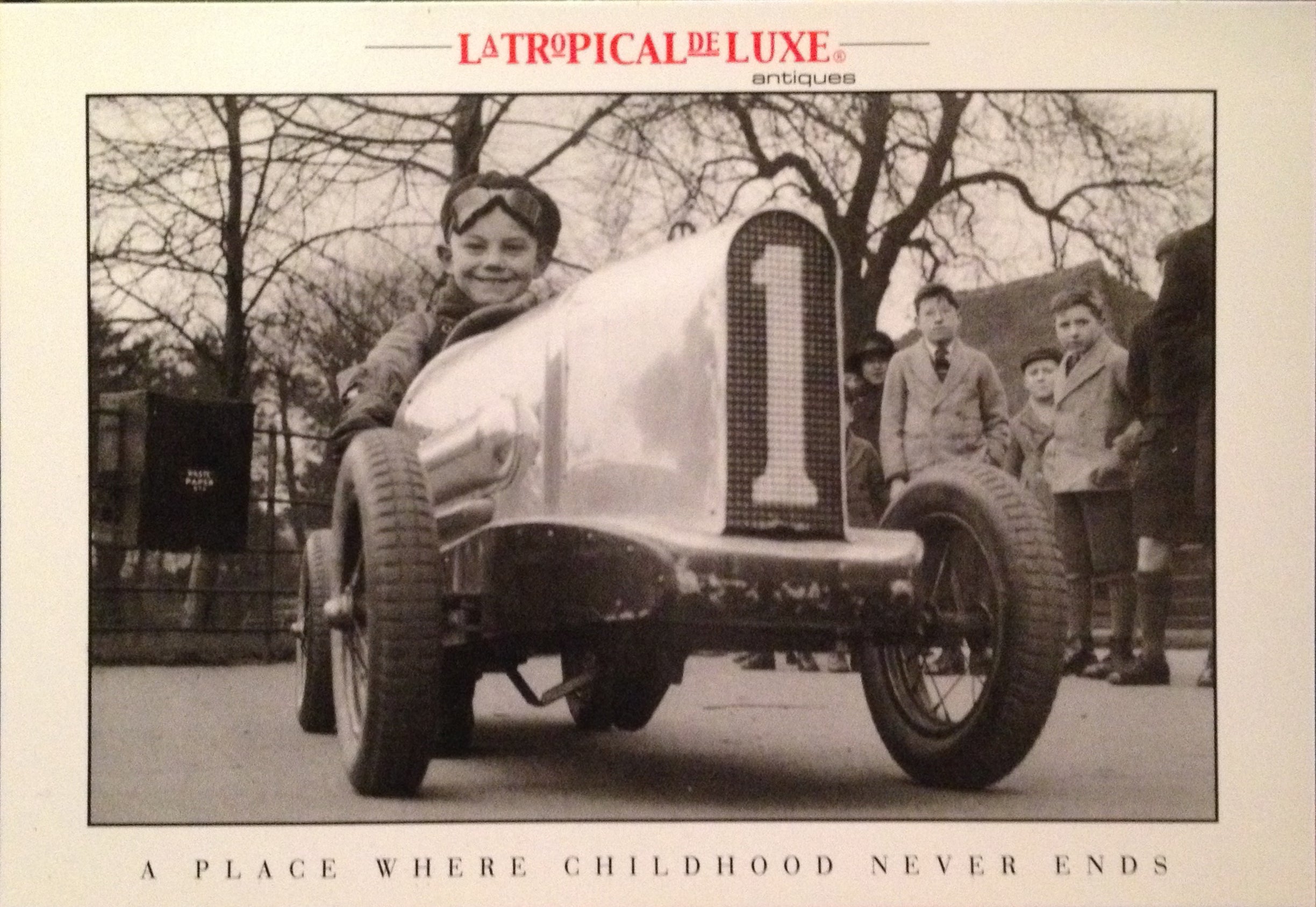
About the Seller
4.9
Vetted Professional Seller
Every seller passes strict standards for authenticity and reliability
Established in 2002
1stDibs seller since 2016
320 sales on 1stDibs
Typical response time: 1 hour
- ShippingRetrieving quote...Shipping from: Buenos Aires, Argentina
- Return Policy
Authenticity Guarantee
In the unlikely event there’s an issue with an item’s authenticity, contact us within 1 year for a full refund. DetailsMoney-Back Guarantee
If your item is not as described, is damaged in transit, or does not arrive, contact us within 7 days for a full refund. Details24-Hour Cancellation
You have a 24-hour grace period in which to reconsider your purchase, with no questions asked.Vetted Professional Sellers
Our world-class sellers must adhere to strict standards for service and quality, maintaining the integrity of our listings.Price-Match Guarantee
If you find that a seller listed the same item for a lower price elsewhere, we’ll match it.Trusted Global Delivery
Our best-in-class carrier network provides specialized shipping options worldwide, including custom delivery.More From This Seller
View AllErotic - Nude Viena Bronze Sculpture / Paperweight. Austria 1900´s
By Franz Bergmann
Located in Buenos Aires, Olivos
Erotic - Nude Viena Bronze Sculpture / Paperweight. Austria 1900´s.
Lovely woman nude paperclip or paperweight.
We have specialized in the sale of Art Deco and Art Nouveau and Vinta...
Category
Early 20th Century Austrian Art Nouveau Figurative Sculptures
Materials
Bronze
Art Deco Bronze Sculpture Figure of a Naked Woman by Sibylle May, France 1920´s
By Sibylle May
Located in Buenos Aires, Olivos
Art Deco Bronze Sculpture Figure of a Naked Woman by Sibylle May, France 1920´s
A wonderful art deco bronze sculpture by Sibylle May.
Signed in the bronze ...
Category
Early 20th Century French Art Deco Figurative Sculptures
Materials
Marble, Bronze
Leda and the Swan Bronze sculpture by Ferd Otratovsky
Located in Buenos Aires, Olivos
Leda and the Swan Bronze sculpture by Ferd Otratovsky.
Signed and dated "FERD. OTRADOVSKY 1926" within the cast on the base.
Black patinated bronze, mounte...
Category
Early 20th Century French Art Nouveau Figurative Sculptures
Materials
Marble, Bronze
Art Deco Shy Naked Women Bronze, Paperweight, Car Mascot, Hood Ornament
By Luigi Betti
Located in Buenos Aires, Olivos
Lovely Art Deco shy naked women made of bronze and mounted over a green marble base. It is signed L. Betti and foundry Etling Paris. Perfect piece of Autom...
Category
Vintage 1920s French Art Deco Paperweights
Materials
Bronze
Georges Récipon, "Lucky", Gilt Patina Bronze Sculpture / Desk Paperweight
By Georges Récipon, Susse Freres
Located in Buenos Aires, Olivos
Georges Récipon, "Lucky", Gilt Patina Bronze Sculpture / Desk Paperweight. Signed and dated.
Beautiful bronze sculpture (gold patina) representing a naked woman nailed a horseshoe, ...
Category
Antique 1890s French Art Nouveau Figurative Sculptures
Materials
Bronze
Mid-century Nude Lovers Bronze Sculpture Statue By Francesco Messina
By Francesco Messina
Located in Buenos Aires, Olivos
Fantastic Sculpture of a couple of naked lovers kissing, Both nude.
Perfect size, will go perfect in any space.
Francesco Messina (15 December 1900 – 13 September 1995) was an Italian sculptor of the 20th century.
Francesco Messina was born at Linguaglossa in the Province of Catania in a very poor family. Growing up in Genoa, where he also studied and lived until he was 32, he then moved to Milan.
Art historians consider him one of the most important figurative sculptors of Novecento, together with Giacomo Manzù, Arturo Martini, Marino Marini. He is the author of some of the greatest works of the Novecento Italiano[citation needed] and his sculptures are displayed in the most famous museums, among which: Bern, Zürich, Gothenburg, Oslo, Munich, Paris, Barcelona, Berlin, São Paulo, Buenos Aires, Venice, Moscow, Saint Petersburg, Vienna, Washington, D.C. and Tokyo.
From 1922, he began exhibiting his work regularly at the Biennale Internazionale d'Arte in Venice and between 1926 and 1929 he took part in the expos organised by the art group Novecento Italiano in Milan. In 1932, he moved to Milan, where in 1934 he obtained a tenured professorship 1934 in Sculpture at the Accademia di Belle Arti di Brera, of which he became the director within two years.
During those years, about him wrote Carlo Carrà:
Francesco Messina's sculpture is characterised by a simple and grandiose manner, by an idealistic and classic procedure, able to give life to forms which become "ideal images".
In the 1930s, Messina exhibited at important collective expos of Italian art in Barcelona, Berlin, Bern, Gothenburg, Munich, Oslo, Paris, São Paulo, Zurich, while executing various sculptures in many Italian cities. In 1936 he was appointed director of the Accademia di Brera, which position he will keep until 1944. His work was also part of the sculpture event in the art competition at the 1936 Summer Olympics.[
In 1938, Giorgio de Chirico in Rome and Salvatore Quasimodo in Turin presented two personal exhibitions of Messina's work. In 1942 he won the Sculpture Prize at the XXIII Biennale Internazionale d’arte of Venice, where he exhibited fifteen sculptures and seventeen drawings.
In 1943, Messina was appointed Academic Emeritus of Italy. On the collapse of the fascist regime, he was temporarily dismissed from the academy, only because he had been its director during the fascist period. However, by 1947 he had already regained his professorship. In the same period the artist took part in the Graphic & Sculpture Expo at Buenos Aires, in the Muller Gallery, achieve a noticeable success. In 1949 he exhibited at the 3rd Sculpture International held by the Philadelphia Museum of Art in Philadelphia, together with Marino Marini and Picasso.
Romantica, c. 1973 (Fondazione Cariplo)
In 1956 he participated with a personal exhibition at the XXVIII Biennale di Venezia. In 1963 he produced the great monument to Pope Pius XII for St. Peter's Basilica in the Vatican, as well as the bust of Pietro Mascagni for the Teatro alla Scala. In the same year he was awarded the Michelangelo Prize for Sculpture in Florence.
In 1966 Messina was commissioned by Italian RAI to create the Cavallo morente (Dying Horse...
Category
Mid-20th Century Italian Mid-Century Modern Figurative Sculptures
Materials
Bronze
$2,660 Sale Price
30% Off
You May Also Like
Erotic Bronze table bell. Austria, early 20th century.
Located in Buenos Aires, Buenos Aires
Erotic bronze table bell. Austria, early 20th century.
Category
Early 20th Century Austrian Art Nouveau Figurative Sculptures
Materials
Bronze
Erotic bronze sculpture. Austria, early 20th century.
Located in Buenos Aires, Buenos Aires
Erotic bronze sculpture. Austria, early 20th century.
Category
Early 20th Century Austrian Art Nouveau Figurative Sculptures
Materials
Bronze
Large Bronze Sculpture of Nude Women
Located in Praha, CZ
Unique Art Deco statue of a nude in patinated bronze.
Category
Early 20th Century European Figurative Sculptures
Materials
Bronze
Art Deco Nouveau Modern Female Nude Bronze Decorative Figurative Sculpture
Located in Keego Harbor, MI
A lovely modern female nude bronze decorative figurative sculpture. Stylized in an Art Deco or Art Nouveau style. Artist unknown. A romantic and timeless composition. From a private ...
Category
20th Century Figurative Sculptures
Materials
Bronze
Lifesize Bronze Female Sculpture of a Nude
Located in London, GB
Lovely Lifesize Bronze of a Female Nude
This Sculpture was Bought from a Residence in Scotland and was in their Garden for Many Years
Lovely Patina
Category
Mid-20th Century Unknown Art Nouveau Figurative Sculptures
Materials
Bronze
Bronze Sculpture Nude Reclining Female Torso Signed “H. Will” (1977/79)
Located in Berlin, DE
This striking bronze sculpture, signed “H. Will” and dated 1977/79, presents a reclining female torso in a sensual yet abstract form. The partially fragmented figure emphasizes the c...
Category
Late 20th Century Figurative Sculptures
Materials
Bronze
More Ways To Browse
Women Used As Furniture
New England Antiques
Sculpture Stand Table
1895 Antiques
Canada Antiques
Finnish Antiques
South Street Antiques
1970 S Early American Furniture
Ship Bell
Old Bell
Antique Bell Stand
1880s Bronze Sculptures
Erotic Bronze
Antique Gold Bell
Bell Denmark
Antique Erotic Furniture
Vintage Posters Austria
Bells Made In England
